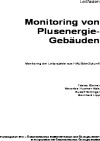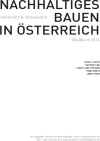Suchergebnisse für "Factsheet: Energietechnologien gestalten, die für alle sinnvoll und nutzbar sind"
Network material ecology for hospitals
The use of sustainable building materials is a key issue for sustainable development of the building sector. Emission free indoor air, minimized embodied energy of construction materials and health risk for construction workers are three main aspects. Between five hospital operators in Austria, Germany and Switzerland a practical exchange of experience focused on material ecology will be initiated and moderated.
"gugler! build & print triple zero" - subproject 2: building with recycros
Building with recycros is working out basics in order to close the cycle of materials in the building sector as well as to increase the usage of recycled materials (recycros). The existing material cycles in the building sector are going to be analysed. Furthermore, there will be a catalogue presented, covering the actual situation of which materials are used in today´s engineering and how the waste is treated. The project will be completed with a summary of results and a proposal of concrete materials and constructional systems for the building project gugler.
Cepheus Cost Efficient Passive Houses As European Standards

Österreichische Teilnahme am Projekt im Rahmen des THERMIE-Programms der Europäischen Kommission
Forschungsforum
2/2001
Herausgeber: BMVIT
Deutsch, 6 Seiten
Downloads zur Publikation
UrbanEnergyCells - Requirements for the implementation of energy cells in future energy system designs
The transformation of the currently hierarchical electricity system into a renewable, decentralized electricity system poses major challenges for the actors in the energy industry and society. Most of the installed decentralized renewable energy sources are installed in rural areas, due to easier legal implementation and shorter decision-making pathways. However, the energy density in urban areas is significantly higher, resulting in a transport of electrical energy to the consumption centers.
Beacon of innovation gugler cross media, ecoeffective zero energy cross media enterprise featuring zero-emission, zero energy, zero waste
The aim of the flagship project is a new dimension of sustainability (cradle to cradle, ecoeffective zero energy enterprise) for business operation and building, which means zero emission, zero energy, zero waste. This will be shown on the basis of a beacon of innovation: Gugler GmbH, a modern sustainable media services enterprise (traditional print and new media) will extend their current building from about 2100 square meters and about 90 employees to about 5,000 square meters.
Enerspired Cities - open and harmonized infomation basis for energy oriented urban planning
In "Enerspired Cities" the concept for an automized junction of judicial secured access regulation to (geo-)energy data is elaborated. This will be adapted to the specific situations in the cities of Innsbruck, Salzburg and Vienna and implemented in dedicated pilot applications. The declared aim is the support of urban planning, monitoring and research by an easy and transparent access to base data coming from various sources for a wide range of users.
Ecological restoration of a listed building with passive house technologies
Ecological exemplary reconstruction of the "Haidenhof"-building, Bad Ischl, Upper Austria. Building refurbishment with respect to monumental protection and newest passive house technologies. Reorganisation of the former residential building to an academy of arts and culture.
"Building of Tomorrow" on the road - knowledge transfer of the results from "Building of Tomorrow" to existing traineeships
Knowledge transfer of the programme "Building of Tomorrow" to specialists on universities, advanced technical colleges, polytechnics, construction academies, administration academies. Themes: Energy, Construction and Building Physics, Ecology and Architecture and Sociology.
baubookPlus - Expansion of an extensive knowledge database of sustainable buildings
By the foundation of the baubook GmbH in 2008 the two databases of building products "öbox" and "ixbau.at" have been merged. The new database baubook was expanded. Essential functions (central product declaration, decentral quality management) and fields of products were added.
Haus der Zukunft in der Praxis Themenworkshop 12: Innovationen im großvolumigen Wohnbau
23. Okt 2006
FFG, Sensengasse 1
1090 Wien, AT
Themenworkshop aus der Reihe Haus der Zukunft in der Praxis
Inter-linked design as a strategy towards sustainable buildings - removing deficiencies of learning and of diffusion

The aim is to investigate the role of inter-linked design team organisation in the design of sustainable buildings and to formulate ready-to-use recommendations and guidelines for dissemination.
Workshop: Anwendung der Passivhaustechnologie im sozialen Wohnbau
28. Apr 2003
TU Wien, Prechtlsaal, Karlsplatz 13, Hauptgebäude, Stiege 1, ErdgeschossWien, AT
Startworkshop zum Projekt aus der Programmlinie "Haus der Zukunft"
Urban district heating extended – Development of flexible and decarbonized urban district heating systems
Development of innovative urban district heating systems by integration of long-term thermal storage, large scale heat pumps, large scale solar thermal installations, waste heat recovery and analysis and evaluation by simulation. The results of this project will provide templates for technology selection, system design and merit order for new urban district heating areas.
Ecological Passive houses

Discussion of transfer of know how for ecological passivehouses, networking (national and international)
School vent cool - Ventilation, cooling and strategies for high performance school renovations
Based on a building typology, strategies for prefabrication for high-quality thermic-energetic renovation of school buildings were developed. New solutions for ventilation systems to achieve good air quality and shading systems were analysed and tested. The "School vent cool" method for renovation of schools has been developed.
Development and application of an consultancy model to promote sustainable building design

Development of an consultancy model to promote ecologic and economic sustainable building solutions within the planning process. Analysis of the efficiency of guided (integral) meetings with architects, planners, and experts for different items.
"gugler! build & print triple zero" - subproject 4: energy concept Gugler
The energy concept led Gugler in frame of the conversion and expansion of the company towards plus-energy standard. Significant measures ware a consequent maximum reduction of the energy demand, optimal utilisation of industrial waste-heat, maximum consumption of on-site energy sources, integrated energy production, ecologic load management with comprehensive response- and storage-techniques.
Monitoring von Plusenergie-Gebäuden - Leitfaden (Nov. 2014)

Monitoring der Leitprojekte aus Haus der Zukunft
Tobias Steiner, Veronika Huemer-Kals, Rudolf Bintinger, Bernhard Lipp
Herausgeber: IBO - Österreichisches Institut für Bauen und Ökologie GmbH in Kooperation mit Österreichisches Ökologie-Institut
Deutsch, 74 Seiten
Downloads zur Publikation
Nachhaltiges Bauen tatsächlich & nachweislich in Österreich - Weißbuch 2015 (Nov. 2014)

Robert Lechner, Bernhard Lipp, Beate Lubitz-Prohaska, et al.
Herausgeber: Österreichisches Ökologie-Institut in Kooperation mit IBO - Österreichisches Institut für Bauen und Ökologie GmbH
Deutsch, 104 Seiten
Downloads zur Publikation
LivingMODELofTomorrow
Development of transparent, technical and economic models for medium and high volume residential buildings, with special focus on the non-profit sector. Topics such as generation living, teleworking as well as smart homes are developed in an integrated model, for dense structures as well as pavillons and townhouses. All models follow the three pillars of sustainability.
